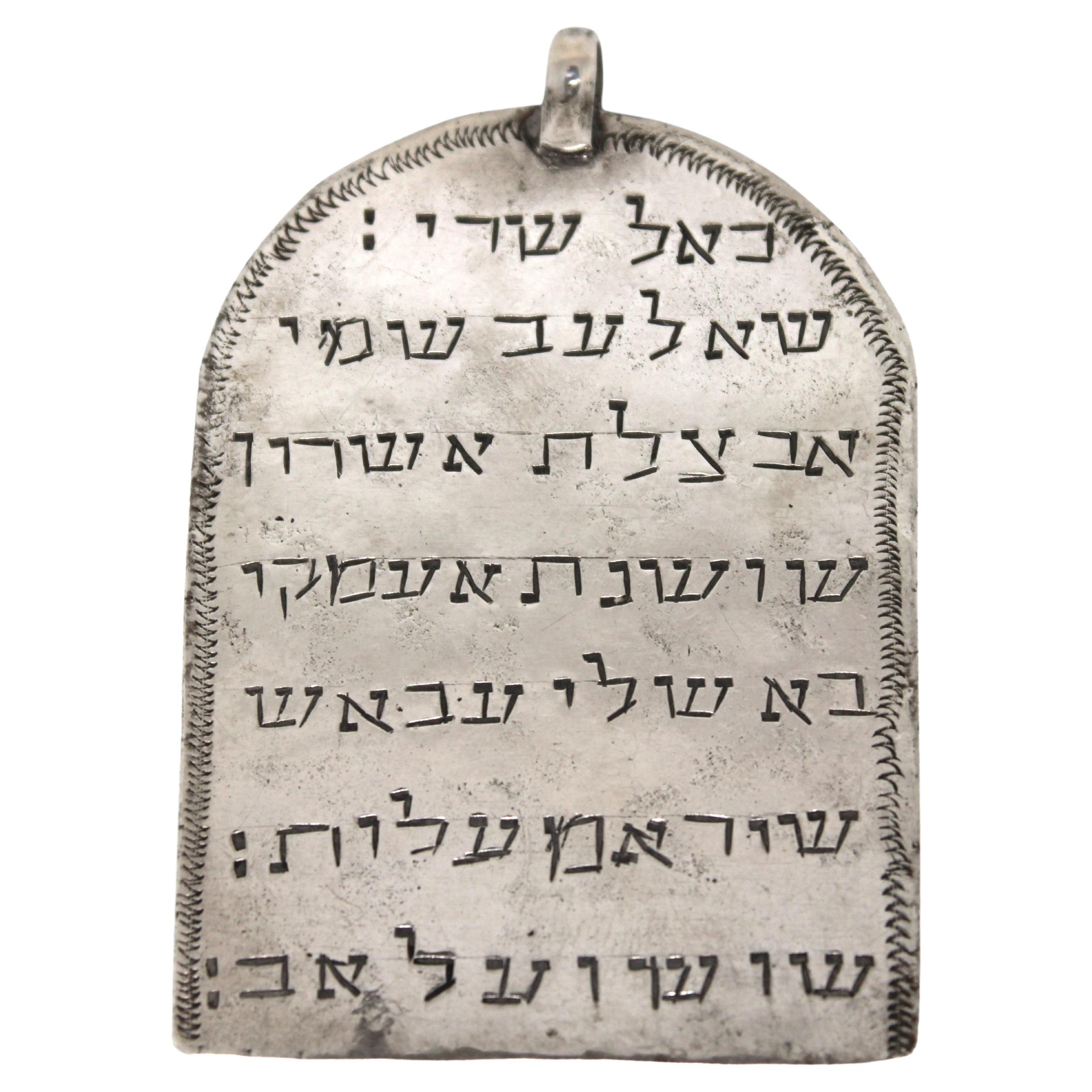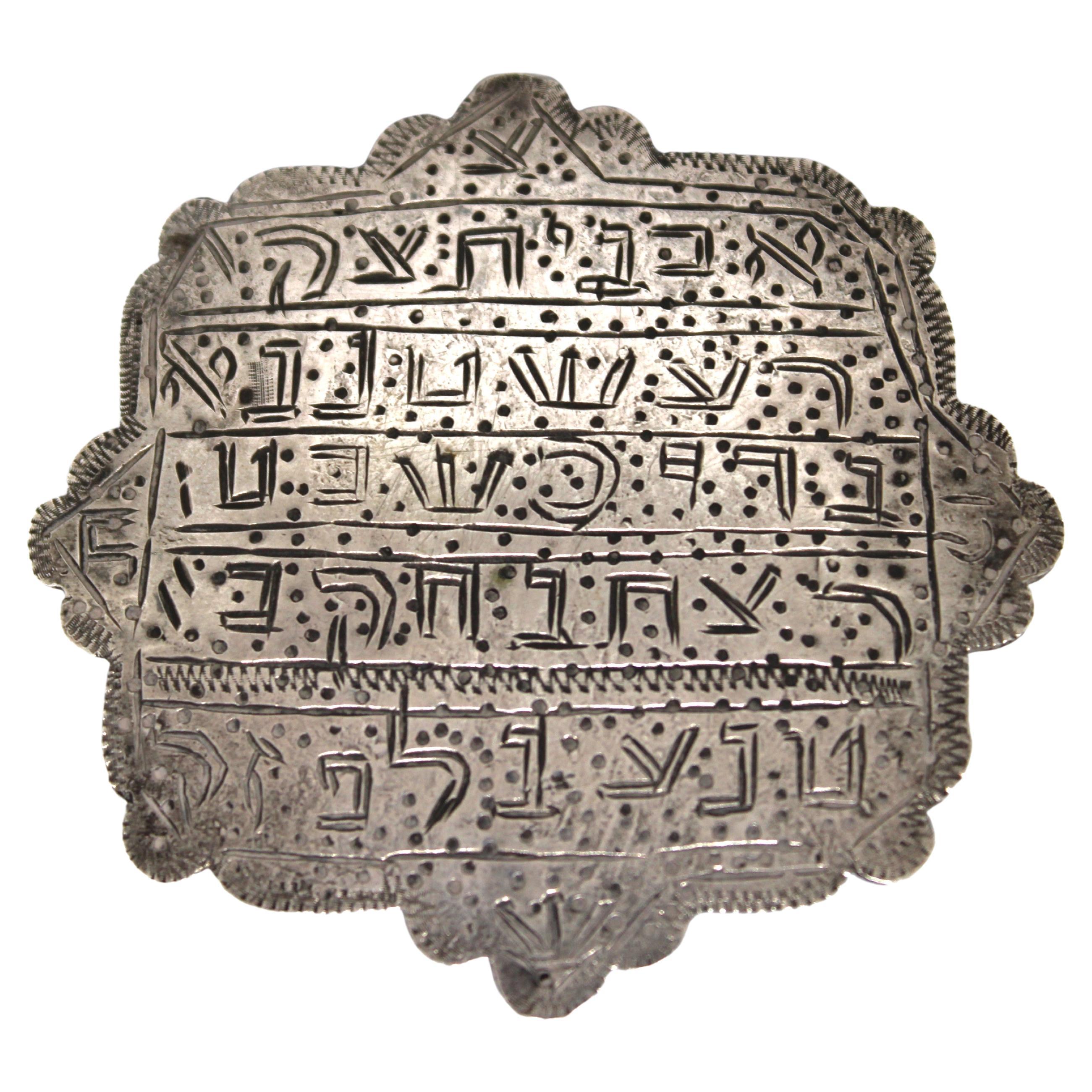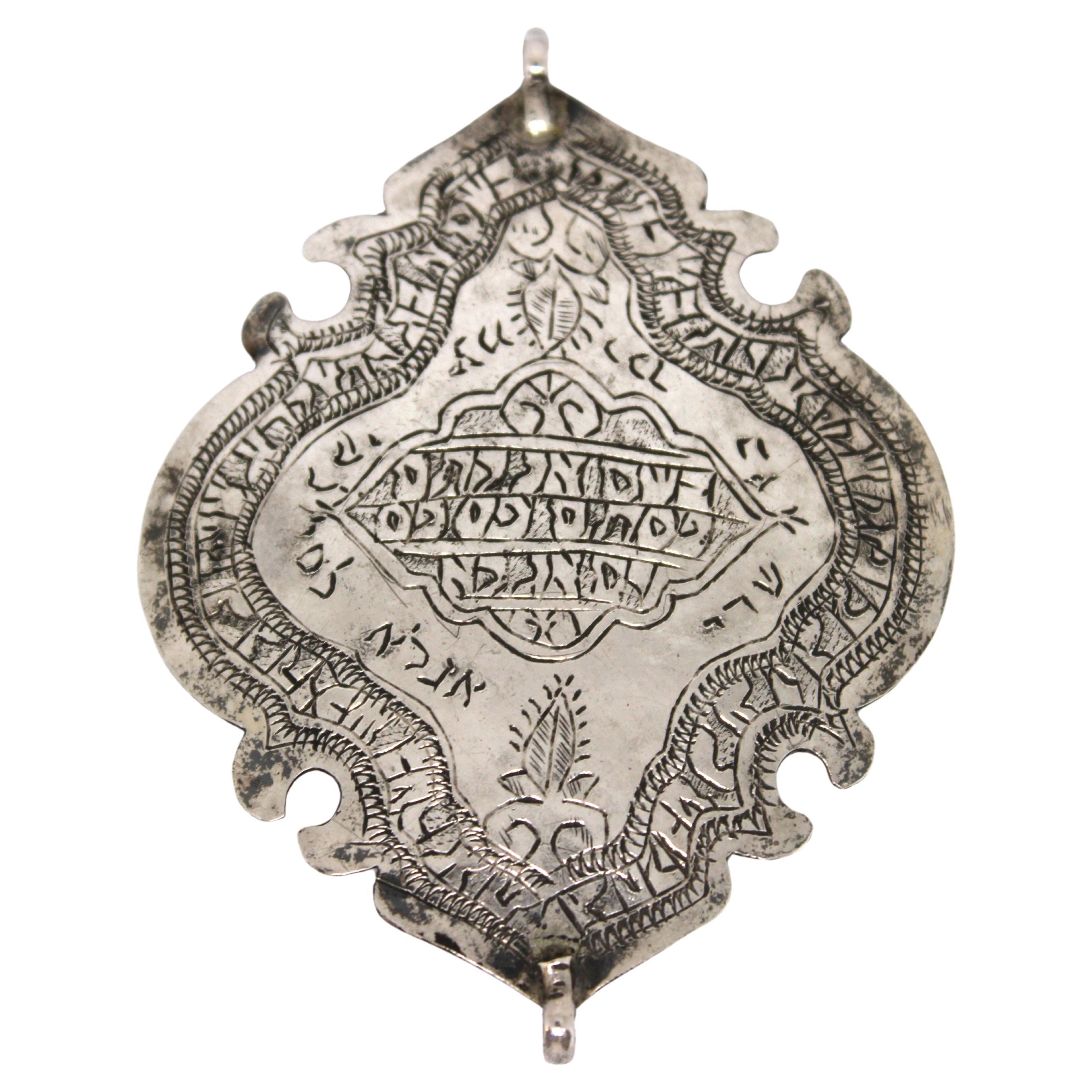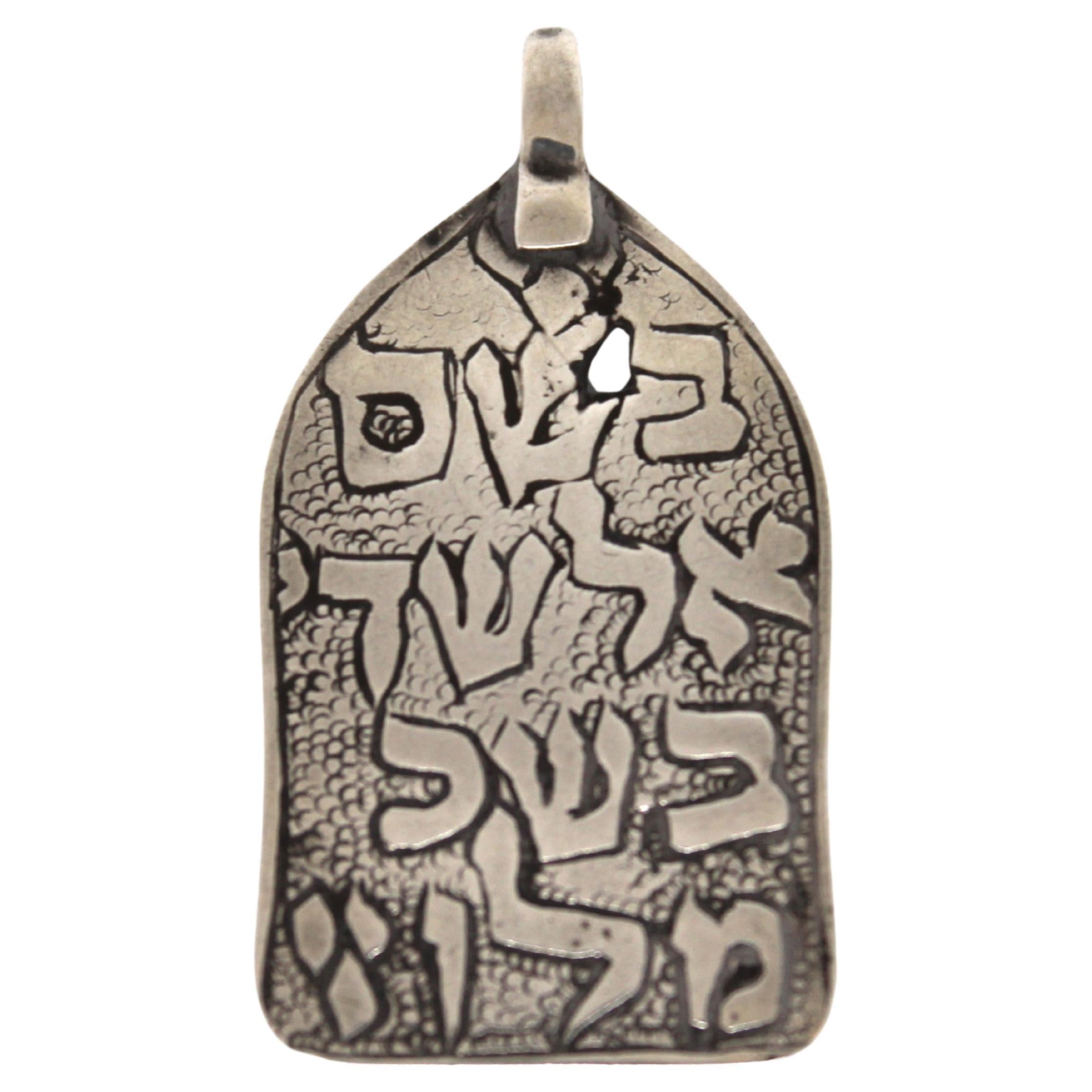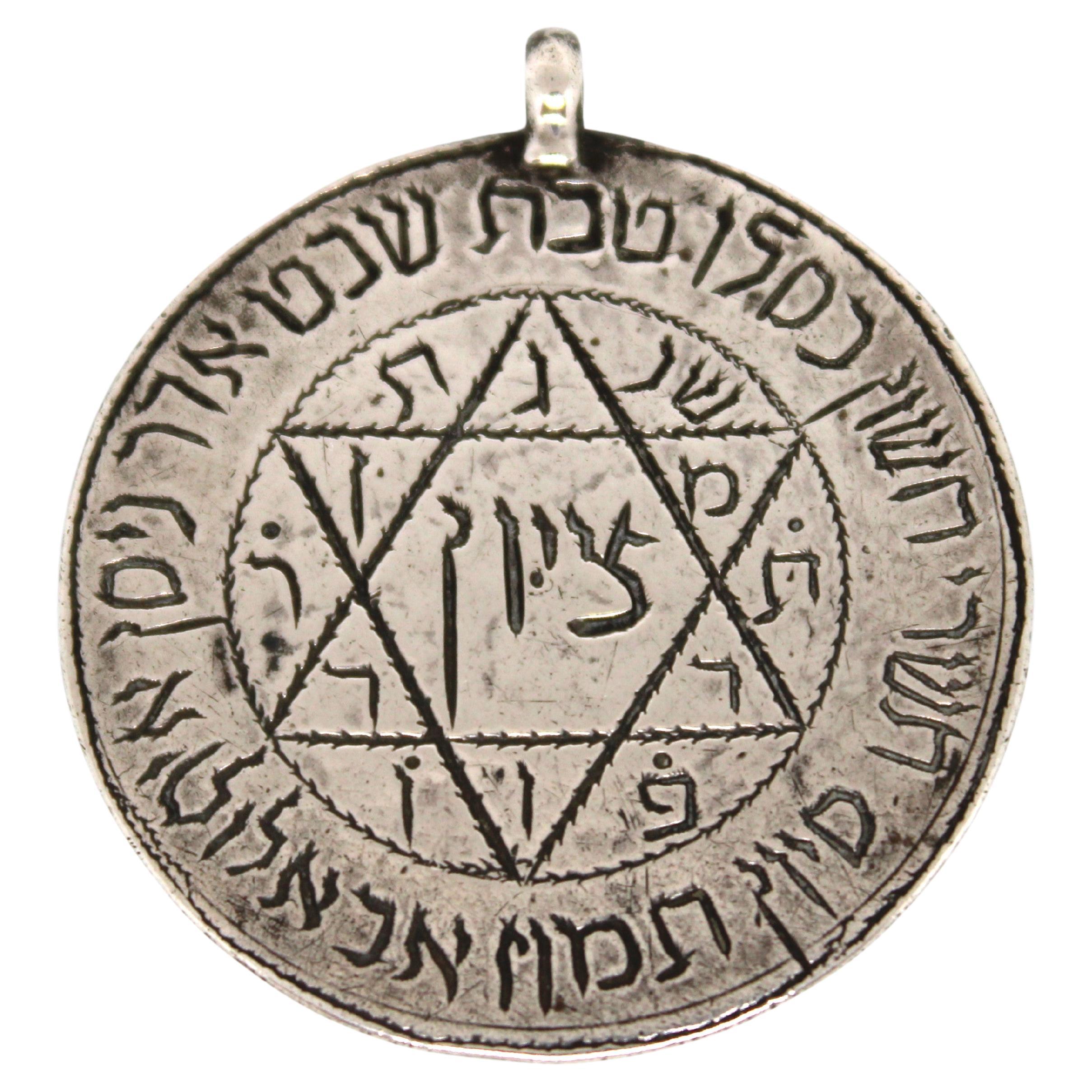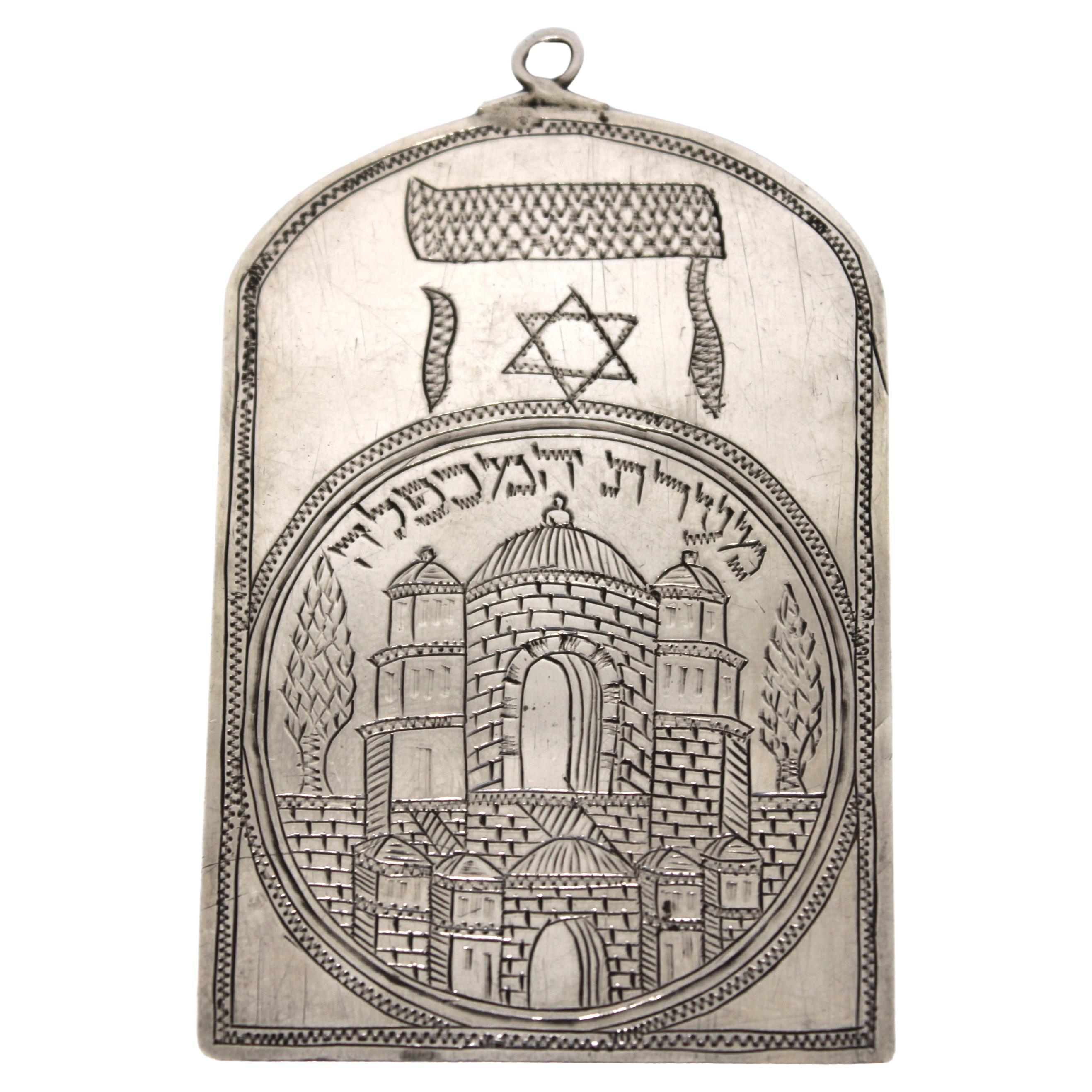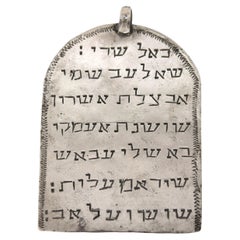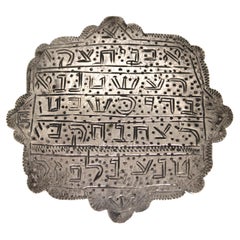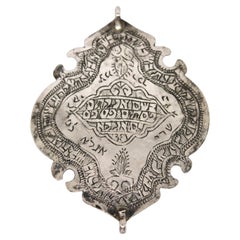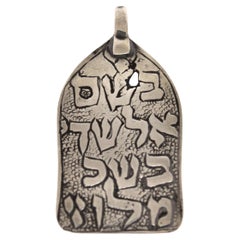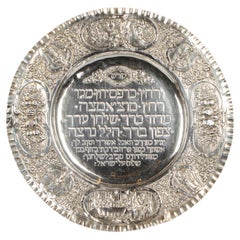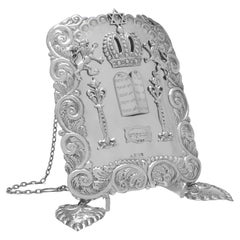Items Similar to An Iraqi Large Silver Amulet, Fine Antique Judaica from Iraq
Want more images or videos?
Request additional images or videos from the seller
1 of 5
An Iraqi Large Silver Amulet, Fine Antique Judaica from Iraq
$1,900
£1,459.70
€1,677.18
CA$2,672.59
A$3,002.53
CHF 1,568.83
MX$36,647.28
NOK 19,919.51
SEK 18,750.03
DKK 12,515.73
About the Item
This exceptional and unusually large silver amulet from Iraq stands out as a powerful artifact of Jewish mysticism and personal devotion. Crafted with great care, the amulet features a commanding rectangular tablet form bordered by a prominent raised beaded edge, giving it both visual weight and symbolic gravitas.
At the top of the amulet’s front panel are two sacred names of God—יהוה (YHWH) and שדי (Shaddai)—engraved side by side, signifying divine protection and invoking both transcendental and immanent aspects of the Divine. Below these holy names unfolds a meticulously engraved column of kabbalistic inscriptions, composed of mystical formulas and sacred permutations traditionally used to guard the wearer from harm and spiritual peril.
In a particularly poignant and personal touch, the final line of the inscriptions contains the name of the individual this amulet was created to protect: שרה בת רחל (Sarah bat Rachel), lovingly inscribed in Hebrew. This inclusion reflects a long-standing tradition in Jewish amulet-making, where the spiritual efficacy of the text is tied directly to the individual named.
Due to its substantial size and weight, the amulet features two large loops at the top, designed to accommodate a sturdy chain so it could be worn securely around the neck. This practical feature further underscores its intended daily use as both a spiritual safeguard and a personal talisman.
2.06ozt
- Dimensions:Height: 3.23 in (8.2 cm)Width: 3.23 in (8.2 cm)Depth: 0.32 in (8 mm)
- Materials and Techniques:Silver,Engraved
- Place of Origin:
- Period:
- Date of Manufacture:20th Century
- Condition:Wear consistent with age and use.
- Seller Location:New York, NY
- Reference Number:1stDibs: LU5281244779412
About the Seller
5.0
Recognized Seller
These prestigious sellers are industry leaders and represent the highest echelon for item quality and design.
Established in 2006
1stDibs seller since 2020
131 sales on 1stDibs
Typical response time: 1 to 2 days
- ShippingRetrieving quote...Shipping from: Pomona, NY
- Return Policy
Authenticity Guarantee
In the unlikely event there’s an issue with an item’s authenticity, contact us within 1 year for a full refund. DetailsMoney-Back Guarantee
If your item is not as described, is damaged in transit, or does not arrive, contact us within 7 days for a full refund. Details24-Hour Cancellation
You have a 24-hour grace period in which to reconsider your purchase, with no questions asked.Vetted Professional Sellers
Our world-class sellers must adhere to strict standards for service and quality, maintaining the integrity of our listings.Price-Match Guarantee
If you find that a seller listed the same item for a lower price elsewhere, we’ll match it.Trusted Global Delivery
Our best-in-class carrier network provides specialized shipping options worldwide, including custom delivery.More From This Seller
View AllAntique Iraqi Judaica Silver Amulet with Kabbalistic Inscriptions
Located in New York, NY
This rare antique Iraqi amulet, tablet-shaped and crafted from silver, embodies the deep spiritual heritage of Middle Eastern Judaica. Its elegant form is framed with a beautifully e...
Category
Early 20th Century Iraqi Sterling Silver
Materials
Silver
An Iranian Silver Amulet, Antique Judaica from Iran
Located in New York, NY
This striking antique silver amulet from Iran is a beautiful example of Persian Jewish craftsmanship. Its scalloped, shield-like form is meticulously ha...
Category
Early 20th Century Persian Sterling Silver
Materials
Silver
Antique Iranian Silver Amulet – Fine Judaica from Persia
Located in New York, NY
This exceptional antique silver amulet from Iran exemplifies the refined craftsmanship and spiritual depth of Persian Jewish heritage. Shaped in an elegant, lobed diamond form with delicately contoured edges, the amulet is engraved with intricate detail, reflecting both artistic sophistication and religious devotion.
At the center, a stylized cartouche is inscribed with Hebrew text, likely invoking divine names or protective blessings — a hallmark of traditional Jewish amulets. Surrounding the central panel, a beautifully flowing engraved border in the form of a pointed arch or mihrab motif lends the piece a sacred architectural presence, often interpreted as a symbolic gateway to divine protection. Further floral and foliate elements are engraved into the design, subtly blending nature with mysticism.
Additional Hebrew inscriptions encircle the inner medallion and appear along the edges, each rendered in clean, carefully etched lines. The amulet features four suspension loops — one at each cardinal point — suggesting it may have once been sewn onto clothing, hung in a home, or worn as a protective charm close to the body.
Rich in symbolism and cultural meaning, this rare Iranian silver...
Category
Early 20th Century Persian Sterling Silver
Materials
Silver
A North African Silver Amulet, Antique Judaica from North Africa
Located in New York, NY
This exquisite antique silver amulet from North Africa is a fine example of regional Judaica, rich in spiritual significance and traditional craftsmanship. Small and tablet-shaped, t...
Category
Early 20th Century African Sterling Silver
Materials
Silver
An Israeli Silver Amulet, Rare Judaica Amulet from Israel, 1936
Located in New York, NY
This rare and meaningful silver amulet, crafted in the Land of Israel in 1936, beautifully reflects the spiritual and cultural heritage of the Jewish people during a pivotal moment i...
Category
Vintage 1930s Israeli Sterling Silver
Materials
Silver
A Silver Amulet, Tzefat Circa 1890
Located in New York, NY
Rare Silver Amulet, Tzefat (Safed), Circa 1890
This extraordinary silver amulet, crafted in the sacred city of Tzefat circa 1890, is a rare and important artifact of Jewish devotion...
Category
Antique 1890s Israeli Sterling Silver
Materials
Silver
You May Also Like
Important 18th century Persian Jewish silver Amulet for mother and newborn
Located in Tel Aviv - Jaffa, IL
Mysterious Amazing, 18th century silver talismanic amulet, Amulet for mother and Newborn with image of Lilith in the center made by Jews in Persia, the top of the Amulet has an amazi...
Category
Antique 1790s Tribal Art
Materials
Agate, Silver
extremely rare Algerian Judaica silver, jewish Dowry box early 19th century
Located in Tel Aviv - Jaffa, IL
Amazing and scarce JUDAICA object, we have here one of the most touching jewish objects we had for a long time, this small silver dowry box was made in Algeria in the early 19th century, it is all covered with symbols of jewish faith and of couples, the sliding lid has 2 flanking birds with hamsa (protective hand) on each side and a flower vase in the middle.
one side shows two flanking lions with a tree in the middle and the other side shows again two big and two small birds with a flower bowl in the middle, front side has a key hole and next to it there is the Hebrew inscription ס״ט״" which says Siman tov or in English "a good sign" it is taken from the wedding blessing, underneath the lock there is another inscription with the name ״עזיזה בת אברהם בן חמו״ which is the name of the bride, her father and her grandfathers name.
the box is full marked a lot of times with the silversmith mark, every side of the box is marked.
this box was probably ordered by the grooms family to hold the jewelry they are giving to the bride as dowry, this type of objects are rare and there are just a few of them on museum collections.
DOWRY (Heb. נְדֻנְיָה), the property a wife brings to her husband at marriage; the Yiddish equivalent, nadn, is from the same root. The custom of nedunyah became clearly defined and institutionalized only in the talmudic period. In biblical times, mohar (מֹהַר), whereby the groom bought his wife from her father (Gen. 24:53; Ex. 22:15–16; Hos. 3:2), was the accepted practice. It was then customary that the groom give the bride gifts, and that she bring certain property to her husband's home upon marriage: slaves, cattle, real estate, etc. (cf. Gen. 24:59–61; 29; Judg. 1:14ff.; I Kings 9:16). Evidence of the custom of nedunyah is to be found in Tobit (7:14; 8:21) and in the Assuan papyri (Cowley, Aramaic, nos. 15, 18). Gradually, mohar was superseded by the ketubbah custom according to which the husband merely assumed the responsibility of compensation to his wife in case he divorced her: he had to pay her 200 zuzim if she had been a virgin at the time of marriage, and 100 zuzim if a widow or divorcée (see *Ketubbah).
By talmudic times, the institution of nedunyah was prevalent; the father gave a dowry to the bride since the daughter was excluded from paternal inheritance. Fifty zuzim (equivalent to the worth of 180 grams of silver) was the minimum amount a father was obliged to give to his daughter (Ket. 6:5). Parents usually gave much more, according to their social standing. Community funds provided the dowry for an orphan or a very poor girl (ibid.; cf. Sh. Ar., YD 251:8). In case of her father's death, the brothers of a minor girl were obliged to give her the minimum dowry, and the court estimated how much her father would have given her above the minimum dowry. The sum was then taken out of the father's estate and given to the daughter upon majority (Ket. 6:6; 68a–69b). In the absence of such an estimate, each daughter was entitled to receive one-tenth of the value of her father's estate in money, or in valuables (Yad, Ishut, 20:4–7; Sh. Ar., EH 113:4). If the father was unable or unwilling to pay the promised dowry at the betrothal ceremony, the groom could refuse to marry his bride (Ket. 13:5; Ket. 108b–109a). Insistence on exact payment of the promised dowry, however, was frowned upon by later rabbinic authorities (Rema to Sh. Ar., EH 2:1). In certain communities it was customary for the groom's father to make a dowry contribution equal to that of the bride's father (Ket. 102b). The dowry, whether given in real estate, slaves, money, or chattel was recorded in the marriage contract (the ketubbah) and in some instances one-third or one-fifth of the actual value of the dowry was added to the sum mentioned in the ketubbah. Based upon a decree enacted by *Simeon b. Shetah (first century C.E.), the Talmud ruled that the husband and his entire property were liable for compensation as stipulated in the ketubbah, either in case he died (when she collected the sum specified in the ketubbah from the heirs) or in case he divorced his wife (Ket. 82b). For the status of the dowry and the husband's rights and obligations, see below. The rabbinic enactments (Takkanot Shum) by R. Jacob *Tam and by the rabbinic synod of the communities of Speyer, Worms, and Mainz (Germany) stipulated that if a woman died...
Category
Antique Mid-19th Century Algerian Tribal Art
Materials
Silver
German Silver Seder Plate, Early 20th century
Located in New York, NY
The well embossed with Hebrew blessings, the wide border with two large quatrefoil panels with scenes of the sacrifice of Isaac and the Five Rabbis of Benei Brak, alternating with tw...
Category
Early 20th Century Sterling Silver
Materials
Silver
Antique Sterling Silver Breastplate - Judaica - London 1922 Jacob Rosenzweig
Located in London, London
Hallmarked in London in 1922 by Jacob Rosenzweig, this Antique Sterling Silver Breastplate, is of traditional form, decorated with two Lions of Judah holding a depiction of the Crown...
Category
Vintage 1920s English Religious Items
Materials
Sterling Silver
Large Russian Silver Jewish Megillah Case and Scroll
Located in London, GB
A large Russian silver Jewish Megillah case and scroll
Russian, 19th century
Measures: height 23cm, diameter 7cm
This remarkable piece is a Russian ...
Category
Antique 19th Century Russian Religious Items
Materials
Silver
Antique Persian Arab Islamic Silver Engraved Calligraphy Quran Case Amulet 1820
Located in Portland, OR
A good antique early 19th century Persian silver engraved Holy Qur'an case amulet, circa 1820.
This type of Qur'an case is known in Persian as a Bazuband, these cases were worn on t...
Category
Antique 1820s Persian Islamic Sterling Silver
Materials
Silver
More Ways To Browse
Antique Sterling Chain
Antique Amulet
Silver Amulet
Silver Iraq
Jewish Amulet
Pierce Martin
Rams Head Sterling
Sheffield Stainless England
Silver Asparagus Tongs
Silver Holloware
Silver Skewer
Sterling Bread Basket
Sterling Silver Bread Baskets
Sterling Silver Combs
Sterling Silver Ice Scoop
Sterling Tea Urn
Tiffany 925 1000
Tiffany Place Setting
